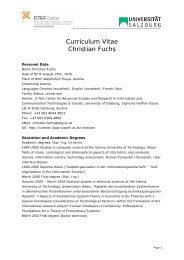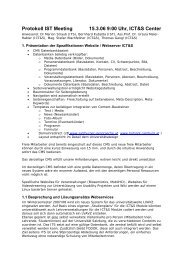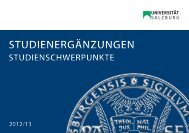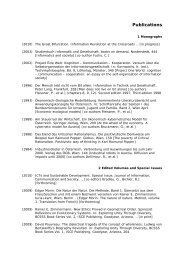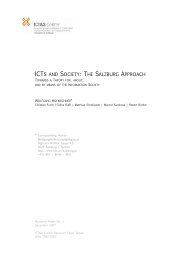CHRISTIAN FUCHS - ICT&S - Universität Salzburg
CHRISTIAN FUCHS - ICT&S - Universität Salzburg
CHRISTIAN FUCHS - ICT&S - Universität Salzburg
You also want an ePaper? Increase the reach of your titles
YUMPU automatically turns print PDFs into web optimized ePapers that Google loves.
Christian Fuchs: Social Networking Sites and the Surveillance SocietyNewspaper TitleNumber of articles on the amendment ofthe Security Police Act (November 22-December 20, 2007, Source: APA DeFacto,www.defacto.at)Audience Scope (% ofpopulation consuming amedium, Mediaanalyse2007/2008, mediaanalyse.at)Kronen Zeitung 0 42.2%Kleine Zeitung 7 11.7%Kurier 4 8.7%Der Standard 3 5.0%Oberösterreichische 1 4.8%NachrichtenDie Presse 2 3.6%<strong>Salzburg</strong>er1 3.6%NachrichtenVorarlberger 5 2.9%NachrichtenTotal 23Table 14. Number of articles on the amendment of the Security Police Act in selectedAustrian newspapers (November 22-December 20, 2007; Source: APA DeFacto, searchkeyword: Sicherheitspolizeigesetz)There was low media coverage on the amendment of the Austrian Security Police Act inDecember 2007. This is not an empirical prove, but an indication that there is not muchmedia coverage and public problematization of surveillance in Austria. A lack ofinformation and of public discussion could be one of the reasons why the students inour survey tend to be rather critical of surveillance, but tend to have little knowledge ofthe actual judicial situation of surveillance in Austria and Europe.7.4. Usage of studiVZ88.3% of our respondents are studiVZ users (figure 17). This confirms the fact thatstudiVZ is the most used ISNS in Austria and Germany. 91.8% of the studiVZ usersanswered correctly that studiVZ gathers and stores data about their usage behaviour(figure 18). 85.6% of the studiVZ users know that studiVZ does not reuse and resellpersonal data of users (figure 19). These two results show that students in <strong>Salzburg</strong> havea relatively good knowledge of what studiVZ is allowed and not allowed to do withtheir data. 46.6% of the studiVZ users have read the new terms of use that wereintroduced at the beginning of 2008, whereas 41.8% have not read them (figure 20).This is a relatively balanced distribution. For the majority of users (55.2%), trust intostudiVZ has remained the same after the new terms of use took effect. For a smallminority, trust has increased (6.1%), for 38.7% it has decreased (figure 21). 75.0% ofthe studiVZ users have deactivated to receive messages from studiVZ advertising clientsper email or the studiVZ message service (figure 22). 58.04% have deactivatedreceiving personalized advertisements (figure 23). 69.1% have deactivated the optionthat studiVZ can send them announcements on new features (figure 24). Combiningthese three information behaviours by adding one point for each deactivation, wecalculated the studiVZ information behaviour index (figure 25). 22.6% of the studiVZusers in our sample have no safety from advertisements, 7.8% low safety, 20.5% somesafety, and 49.2% good safety.69



